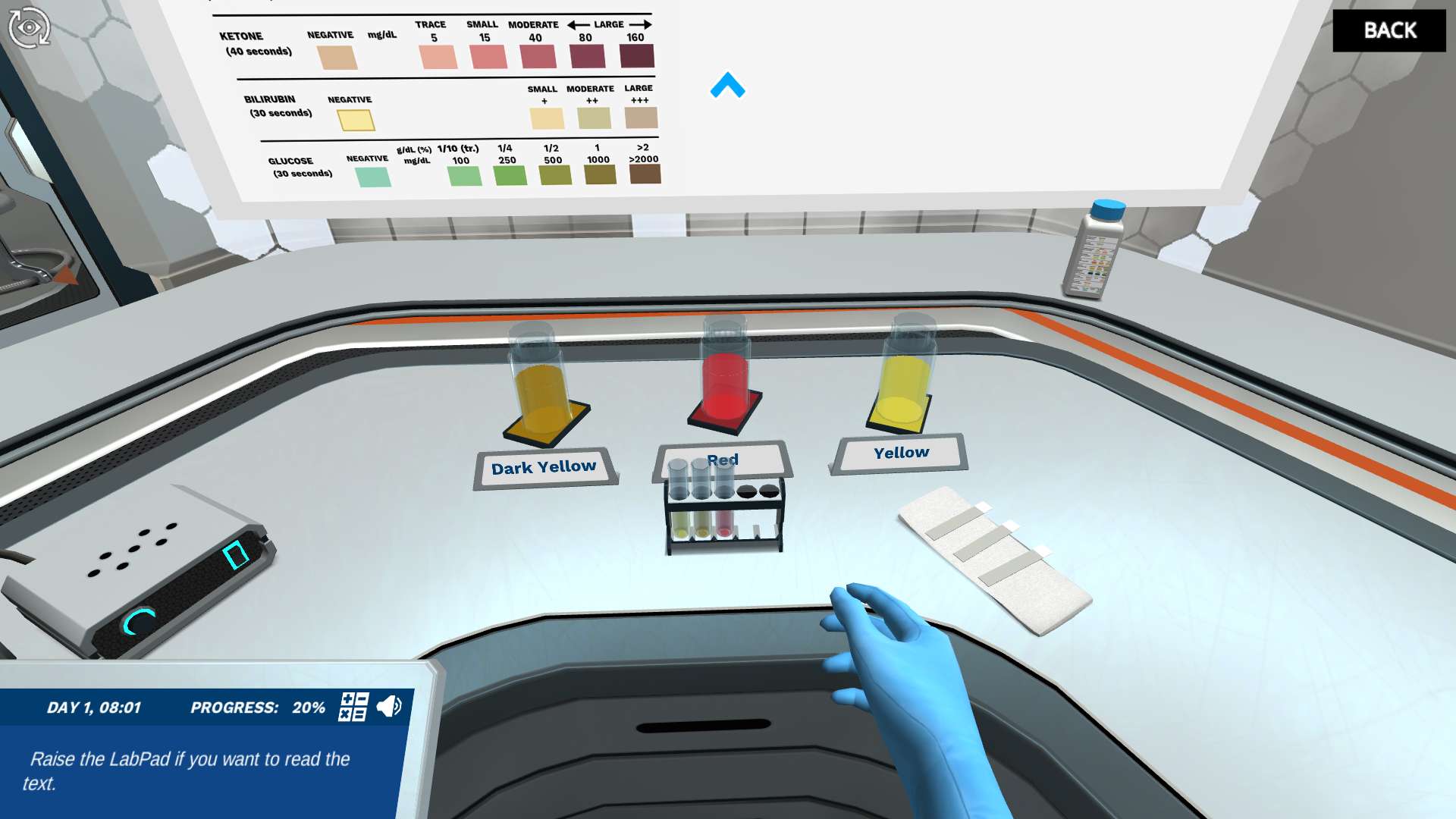Heading 1
Heading 2
Heading 3
Heading 4
Heading 5
Heading 6
Lorem ipsum dolor sit amet, consectetur adipiscing elit, sed do eiusmod tempor incididunt ut labore et dolore magna aliqua. Ut enim ad minim veniam, quis nostrud exercitation ullamco laboris nisi ut aliquip ex ea commodo consequat. Duis aute irure dolor in reprehenderit in voluptate velit esse cillum dolore eu fugiat nulla pariatur.
Block quote
Ordered list
- Item 1
- Item 2
- Item 3
Unordered list
- Item A
- Item B
- Item C
Bold text
Emphasis
Superscript
Subscript
About This Simulation
Perform the three stages of urinalysis on a variety of urine samples collected from patients. Apply your knowledge of urine's macroscopic, chemical, and microscopic properties to interpret the urinalysis results and suggest a plausible diagnosis.
Learning Objectives
- Understand how to examine urine by applying macroscopic, chemical, and microscopic tests.
- Recognize reference values for a normal urinalysis
- Interpret the meaning of abnormal urinalysis findings that indicate a possible medical problem, and suggest a reasonable diagnosis.
About This Simulation
Lab Techniques
- Urinalysis
Related Standards
- EHEA First Cycle
- EHEA Short Cycle
- FHEQ 5
- FHEQ 6
- SCQF 9
- SCQF 8
- SCQF 7
- US College Year 2
- US College Year 1
- Early Stage Bachelors Level
Learn More About This Simulation
What's wrong with my urine? In this simulation, you will perform urinalysis - a simple, non-invasive technique where a patient's urine is analyzed to determine possible health conditions they may have. Urinalysis has three stages: macroscopic, chemical, and microscopic analysis. Perform all three stages and interpret your results to suggest possible causes for your patients concerning urine. Can you suggest a diagnosis for your patient's urine?
Perform the dipstick test
Your mission is to analyze three urine samples with concerning properties. First, you will learn how the color and smell of urine are related to a patient's health, hydration, and the food they consume. Gain a deeper understanding of what is going on in these urine samples by performing the dipstick test. Compare the colors on the reference chart to your dipstick to determine the levels of different substances in the urine.
Analyze a urine sample under the microscope
Confirm the results of the dipstick test with microscopic analysis. Investigate cells and microorganisms in the urine samples to discover if there is a normal or abnormal number of them. Interpret what abnormal numbers of white blood cells and bacteria could mean. Once you have completed all three urinalysis stages, you are ready to suggest possible causes for your three patients concerning urine.
Suggest a possible diagnosis
Meet Aaron, one of the patients who gave you a urine sample. Explain what you discovered about Aaron's bright red urine, reassure them, and test your knowledge of urinalysis. Can you provide Aaron with a reasonable diagnosis?
For Science Programs Providing a Learning Advantage
Boost STEM Pass Rates
Boost Learning with Fun
75% of students show high engagement and improved grades with Labster
Discover Simulations That Match Your Syllabus
Easily bolster your learning objectives with relevant, interactive content
Place Students in the Shoes of Real Scientists
Practice a lab procedure or visualize theory through narrative-driven scenarios


FAQs
Find answers to frequently asked questions.
Heading 1
Heading 2
Heading 3
Heading 4
Heading 5
Heading 6
Lorem ipsum dolor sit amet, consectetur adipiscing elit, sed do eiusmod tempor incididunt ut labore et dolore magna aliqua. Ut enim ad minim veniam, quis nostrud exercitation ullamco laboris nisi ut aliquip ex ea commodo consequat. Duis aute irure dolor in reprehenderit in voluptate velit esse cillum dolore eu fugiat nulla pariatur.
Block quote
Ordered list
- Item 1
- Item 2
- Item 3
Unordered list
- Item A
- Item B
- Item C
Bold text
Emphasis
Superscript
Subscript
A Labster virtual lab is an interactive, multimedia assignment that students access right from their computers. Many Labster virtual labs prepare students for success in college by introducing foundational knowledge using multimedia visualizations that make it easier to understand complex concepts. Other Labster virtual labs prepare learners for careers in STEM labs by giving them realistic practice on lab techniques and procedures.
Labster’s virtual lab simulations are created by scientists and designed to maximize engagement and interactivity. Unlike watching a video or reading a textbook, Labster virtual labs are interactive. To make progress, students must think critically and solve a real-world problem. We believe that learning by doing makes STEM stick.
Yes, Labster is compatible with all major LMS (Learning Management Systems) including Blackboard, Canvas, D2L, Moodle, and many others. Students can access Labster like any other assignment. If your institution does not choose an LMS integration, students will log into Labster’s Course Manager once they have an account created. Your institution will decide which is the best access method.
Labster is available for purchase by instructors, faculty, and administrators at education institutions. Purchasing our starter package, Labster Explorer, can be done using a credit card if you are located in the USA, Canada, or Mexico. If you are outside of North America or are choosing a higher plan, please speak with a Labster sales representative. Compare plans.
Labster supports a wide range of STEM courses at the high school, college, and university level across fields in biology, chemistry, physics, and health sciences. You can identify topics for your courses by searching our Content Catalog.















